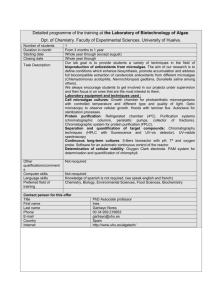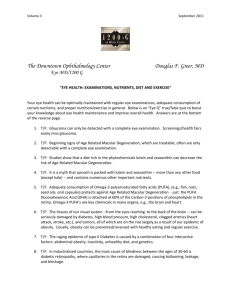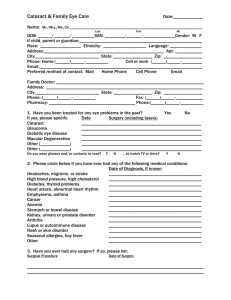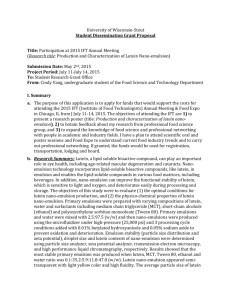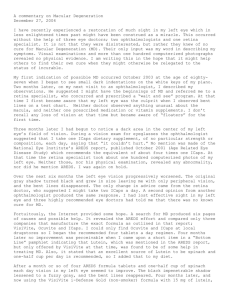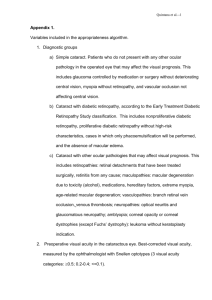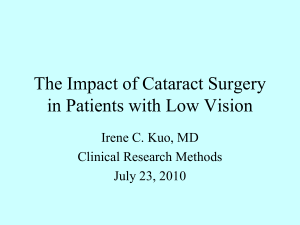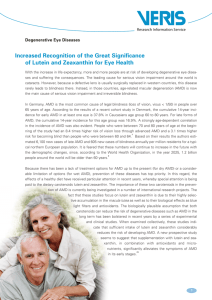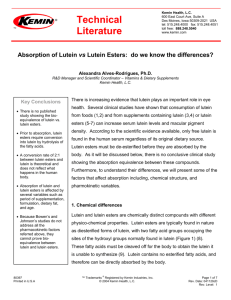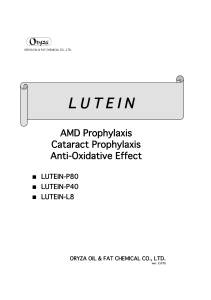now! - International Egg Commission
advertisement
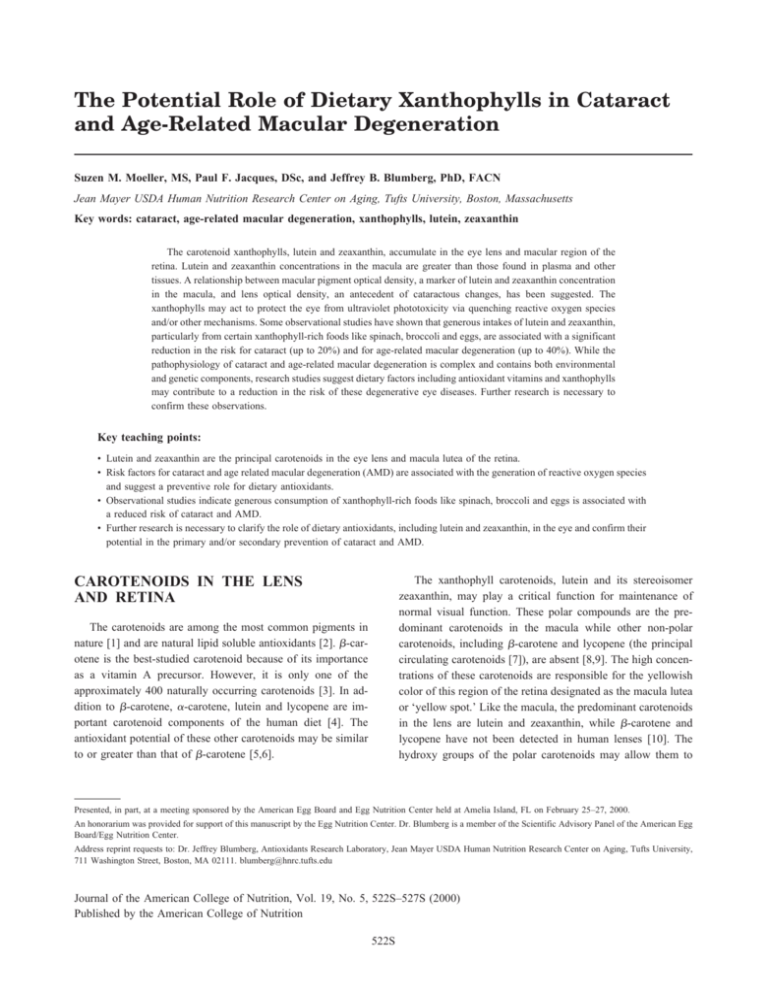
The Potential Role of Dietary Xanthophylls in Cataract and Age-Related Macular Degeneration Suzen M. Moeller, MS, Paul F. Jacques, DSc, and Jeffrey B. Blumberg, PhD, FACN Jean Mayer USDA Human Nutrition Research Center on Aging, Tufts University, Boston, Massachusetts Key words: cataract, age-related macular degeneration, xanthophylls, lutein, zeaxanthin The carotenoid xanthophylls, lutein and zeaxanthin, accumulate in the eye lens and macular region of the retina. Lutein and zeaxanthin concentrations in the macula are greater than those found in plasma and other tissues. A relationship between macular pigment optical density, a marker of lutein and zeaxanthin concentration in the macula, and lens optical density, an antecedent of cataractous changes, has been suggested. The xanthophylls may act to protect the eye from ultraviolet phototoxicity via quenching reactive oxygen species and/or other mechanisms. Some observational studies have shown that generous intakes of lutein and zeaxanthin, particularly from certain xanthophyll-rich foods like spinach, broccoli and eggs, are associated with a significant reduction in the risk for cataract (up to 20%) and for age-related macular degeneration (up to 40%). While the pathophysiology of cataract and age-related macular degeneration is complex and contains both environmental and genetic components, research studies suggest dietary factors including antioxidant vitamins and xanthophylls may contribute to a reduction in the risk of these degenerative eye diseases. Further research is necessary to confirm these observations. Key teaching points: • Lutein and zeaxanthin are the principal carotenoids in the eye lens and macula lutea of the retina. • Risk factors for cataract and age related macular degeneration (AMD) are associated with the generation of reactive oxygen species and suggest a preventive role for dietary antioxidants. • Observational studies indicate generous consumption of xanthophyll-rich foods like spinach, broccoli and eggs is associated with a reduced risk of cataract and AMD. • Further research is necessary to clarify the role of dietary antioxidants, including lutein and zeaxanthin, in the eye and confirm their potential in the primary and/or secondary prevention of cataract and AMD. CAROTENOIDS IN THE LENS AND RETINA The xanthophyll carotenoids, lutein and its stereoisomer zeaxanthin, may play a critical function for maintenance of normal visual function. These polar compounds are the predominant carotenoids in the macula while other non-polar carotenoids, including -carotene and lycopene (the principal circulating carotenoids [7]), are absent [8,9]. The high concentrations of these carotenoids are responsible for the yellowish color of this region of the retina designated as the macula lutea or ‘yellow spot.’ Like the macula, the predominant carotenoids in the lens are lutein and zeaxanthin, while -carotene and lycopene have not been detected in human lenses [10]. The hydroxy groups of the polar carotenoids may allow them to The carotenoids are among the most common pigments in nature [1] and are natural lipid soluble antioxidants [2]. -carotene is the best-studied carotenoid because of its importance as a vitamin A precursor. However, it is only one of the approximately 400 naturally occurring carotenoids [3]. In addition to -carotene, ␣-carotene, lutein and lycopene are important carotenoid components of the human diet [4]. The antioxidant potential of these other carotenoids may be similar to or greater than that of -carotene [5,6]. Presented, in part, at a meeting sponsored by the American Egg Board and Egg Nutrition Center held at Amelia Island, FL on February 25–27, 2000. An honorarium was provided for support of this manuscript by the Egg Nutrition Center. Dr. Blumberg is a member of the Scientific Advisory Panel of the American Egg Board/Egg Nutrition Center. Address reprint requests to: Dr. Jeffrey Blumberg, Antioxidants Research Laboratory, Jean Mayer USDA Human Nutrition Research Center on Aging, Tufts University, 711 Washington Street, Boston, MA 02111. blumberg@hnrc.tufts.edu Journal of the American College of Nutrition, Vol. 19, No. 5, 522S–527S (2000) Published by the American College of Nutrition 522S Xanthophylls in Cataract and Macular Degeneration incorporate into cell membranes in an orderly orientation that stabilizes the membrane [11]. There are no experimental animal data relating carotenoids to cataract formation and only limited data relating carotenoids to age-related macular degeneration (AMD). It has been noted that the macular pigment is depleted in monkeys fed diets deficient in xanthophylls [12] and maintenance on such a diet for up to 14 years resulted in retinal changes, including a loss of retinal pigment epithelial (RPE) cells and increased photoreceptor cell death [13]. Two studies have examined whether dietary intake of lutein can affect macular pigment density in people. In a preliminary study by Landrum et al. [14], two subjects consumed the equivalent of 30 mg of free lutein for 140 days. Macular pigment optical density began to increase after 20 to 40 days and did not level off until 40 to 50 days after supplementation ceased. In one subject, there was a statistically significant difference in the macular pigment optical densities in the right and left eyes, which was maintained throughout the trial. Similarly, Hammond et al. [15] examined the effect of lutein rich foods on thirteen subjects for 6 to 15 weeks. Ten subjects were supplemented with both cooked spinach (1/2 cup/day, providing 10.8 mg lutein and 0.3 mg zeaxanthin) and corn (1 cup/day providing 0.4 mg lutein and 0.3 mg zeaxanthin); one subject received only a spinach supplement, and two subjects received only a corn supplement. Macular pigment density and serum lutein concentration increased in eight of the subjects eating the spinach and corn or spinach only diets. In two subjects, serum lutein increased, but macular pigment optical density did not, while neither serum levels nor macular pigment density increased in one subject. In the two subjects consuming the corn only supplement, only one subject experienced an increase in macular pigment optical density. In those subjects in whom macular pigment density was increased, it remained elevated for up to six months after the trial ended, despite the return of serum lutein levels to baseline. Although these studies are preliminary, they highlight the variable response of macular pigment to dietary manipulation, suggesting that factors other than diet affect macular pigment density. Nonetheless, it appears that, in those individuals that respond to diet, the effect of lutein and zeaxanthinon macular pigment density is not transient. The epidemiological evidence that xanthophyll intake is related to age-related cataract and AMD is summarized below. These studies have particularly considered lutein in the blood or diet and foods that are good sources of lutein, such as spinach and cruciferous vegetables. Eggs, although not the richest dietary source of xanthophylls, are considered a good source of these carotenoids because of the efficient bioavailability of lutein and zeaxanthin from the lipid matrix of the yolks. For example, in a clinical trial, Handelman et al. [16] found increases of lutein and zeaxanthin in plasma of 28% to 50% and 114% to 142% following consumption of 1.3 egg yolks per day for 4.5 weeks, depending on the principal type of JOURNAL OF THE AMERICAN COLLEGE OF NUTRITION fat in the diet. Most studies report combined lutein and zeaxanthin intake. With the exception of a few foods, most notably corn, lutein is the principal component of most foods that are high in these two carotenoids, such as spinach and the cruciferous vegetables. Interpretation of the epidemiological studies is limited by many factors, such as varying case definition and completeness of dietary data for lutein [17,18]. LUTEIN AND AGE-RELATED CATARACT Eight epidemiologic studies have examined the relationship between age-related cataract and lutein levels in the diet or blood or foods that are good sources of lutein. A 1995 retrospective study by Mares-Perlman et al. [19] of 1919 participants in the Beaver Dam Study found that women in the highest quintile category of lutein intake ten years prior to study enrollment (median 949 g/day) had a 27% lower prevalence of more severe nuclear sclerosis (OR: 0.73; 95% CI: 0.5–1.06; p-trend⫽0.02) than women in the lowest quintile category of lutein intake (median 179 g/day). The inverse associations observed between dietary lutein and nuclear sclerosis in men were not statistically significant. Of the lutein-rich foods examined, only spinach was found to be inversely associated with nuclear sclerosis. Women in the highest quintile category of spinach consumption (median 0.7 times/week) were 31% less likely to have more severe nuclear sclerosis (OR: 0.69; 95% CI: 0.50 – 0.95; p-trend⫽0.03) than women in the lowest quintile category of spinach consumption (median 0 times/week). Again, the trend was similar, but not statistically significant, in men. Mares-Perlman et al. [20] also examined the relation between prevalence of nuclear and cortical opacities and nonfasting serum lutein in 400 subjects selected from the Beaver Dam Eye Study cohort. Their observations, based on serum taken at the time of the eye examination in this smaller sample, differed from those reported above, which were based on recall of diet ten years earlier. In general, their analyses indicated either no effect of serum lutein or a significant detrimental association. For nuclear opacification, the odds ratio in men who had serum lutein values in the highest quintile category compared to those in the lowest quintile category was 0.71 (95% CI: 0.27–1.89, p-trend⫽0.93), while the odds ratio for the same comparison in women was 4.1 (95% CI: 1.7–10.0; p-trend⫽0.006). For cortical cataract, the odds ratios comparing the highest and the lowest quintile categories of serum lutein were 4.84 (95% CI: 0.83–28.1, p-trend⫽0.03) for men and 1.75 (95% CI: 0.49 – 6.21, p-trend⫽0.99) for women. Median serum lutein levels ranged from 0.14 – 0.16 mol/L in the lowest quintile to 0.43– 0.45 mol/L in the highest quintile. In 1999, after five years of follow-up, Lyle et al. [21] found that members of the Beaver Dam cohort who were in the highest quintile category of lutein intake 10 years before baseline (median 1,245 g/1000 kcal) were 50% less likely to 523S Xanthophylls in Cataract and Macular Degeneration develop nuclear cataracts (RR: 0.5; 95% CI: 0.3– 0.8; p-trend⫽0.002) than those in the lowest quintile category of intake (median 298 g/1000 kcal). Similar results were obtained using lutein intake at baseline, particularly among subjects ⬍65 years of age (RR: 0.4; 95% CI: 0.2– 0.8; p-trend⫽0.06), although the results for those aged ⱖ65 years were attenuated and not statistically significant (RR: 0.8; 95% CI: 0.4 –1.7; p-trend⫽0.39). As in the first study, consumption of spinach and other dark leafy greens at baseline was inversely associated with risk of nuclear cataract. Persons whose consumption of spinach and other dark leafy greens was in the highest quintile category had a relative risk of 0.6 (95% CI: 0.4 – 0.9; p-trend⫽0.02) compared to those in the lowest quintile category. Egg consumption was also inversely associated with nuclear cataract risk among members of the cohort who were ⬍65 years old at baseline. A relative risk of 0.4 (95% CI: 0.2– 0.9; p-trend⫽0.004) was reported for persons ⬍65 years who were in the highest quintile category of egg consumption compared to those in the lowest quintile category. Lyle et al. [22] also examined the incidence of nuclear cataract in the subsample of 400 individuals previously studied for cross-sectional associations between serum carotenoids and nuclear cataract. Only 252 of these subjects were eligible for incident cataract and the investigators noted that they had limited power to detect a difference in risk between the highest (median 0.38 mol/L) and lowest (median 0.18 mol/L) thirds of serum lutein concentrations. Nevertheless, an inverse association between serum lutein concentrations and risk of nuclear cataract was observed in people age ⱖ65 years (OR: 0.3; 95% CI: 0.1–1.2; p-trend⫽0.15), although this association was not statistically significant. For people ⬍65 years, the association was positive, although again not statistically significant (OR: 1.4; 95% CI: 0.3– 6.0; p-trend⫽0.73). A 1992 prospective analysis of the Nurses Health Study cohort by Hankinson et al. [23] found that consumption of spinach and other greens at least five times per week compared to less than once a month resulted in a 47% lower risk for cataract extraction during up to eight years of follow-up (RR: 0.53; 95% CI 0.38 – 0.73; p-trend⫽0.001). A similar benefit was not reported for foods high in other carotenoids, including broccoli (RR: 0.78; 95% CI: 0.40 –1.54, p-trend⫽0.53), which is also a good source of lutein. Continued observation of the Nurses Health Study cohort supports a protective role of lutein against cataract. After up to 12 years of follow-up on 77,466 women ⱖ45 years of age, Chasan-Taber et al. [24] reported that women in the highest decile category of lutein and zeaxanthin intake (median 13,701 g/day) were 22% less likely to undergo a cataract extraction (RR: 0.78; 95% CI: 0.6 – 0.95; p-trend⫽0.04) than women in the lowest quintile category of intake (median 1,172 g/day). Consistent with earlier results, increased frequency of consumption of spinach and other greens, especially cooked spinach and kale, was associated with decreased risk for cataract extraction. Consumption of cooked spinach at least twice per week resulted in a 30% to 524S 38% decreased risk of cataract extraction compared to those consuming it less than once per month (RR using 1982 FFQ: 0.62; 95% CI: 0.45– 0.86; p-trend⫽0.005). In this report, broccoli intake was inversely associated with the rate of cataract extraction (RR forⱖtwice/week vs. ⬍once/month using 1982 FFQ: 0.75; 95% CI: 0.59 – 0.95; p-trend⫽0.03). In contrast to Lyle et al. [21], no association was found between cataract extraction risk and consumption of eggs ⱖtwice/week compared to ⬍once/month (RR: 1.03; 95% CI: 0.74 –1.29). A similar prospective study in male health professionals aged ⱖ45 years by Brown et al. [25] found that those in the highest quintile category of lutein and zeaxanthin intake (median 6,871 g) were 19% less likely to develop cataract (RR: 0.81; 95% CI: 0.65–1.01; p-trend⫽0.03) than men in the lowest quintile category of lutein and zeaxanthin intake (median 1,300 g). Those consuming cooked spinach ⬎twice/week compared to ⬍once/month again exhibited an inverse association with cataract extraction risk (RR: 0.51; 95% CI: 0.32, 0.82; p-trend⫽0.08), as did those with higher broccoli consumption RR: 0.77; 95% CI: 0.61– 0.97; p-trend⫽0.02 for ⬎twice/week vs. ⬍once/month). Results of a retrospective case control study by Tavani et al. [26] in Northern Italy also support an inverse association between spinach and cruciferae consumption and cataract risk in 207 cataract extraction patients and 706 controls. Individuals consuming spinach at least ‘occasionally’ were 40% less likely to have had a cataract extraction compared to those who never ate spinach (OR: 0.6; 95% CI: 0.4 – 0.9; p-trend⬍0.05). Those consuming cruciferous vegetables ⬎once per week had a 50% lower rate of cataract extraction than those who consumed cruciferous vegetables ⬍once/week (OR: 0.5; 95% CI: 0.3– 0.8, p-trend⬍0.01). Egg consumption (⬎one egg/week vs. ⬍one egg per week) was not significantly related to risk of cataract extraction (OR: 0.8; 95% CI: 0.6 –1.2). Despite differences in study design, case definition and exposure measurement, these studies demonstrate fairly consistent evidence of a moderately protective association between lutein in the diet and cataract. Spinach and other dark leafy greens, the most concentrated sources of dietary lutein, were most consistently associated with protection against cataract, while associations were less consistent for foods with lower lutein concentrations, such as broccoli and eggs. The inconsistent findings of the Beaver Dam studies which employed serum lutein as an indicator of lutein status may be due in part to their cross-sectional study design [20] and/or small population cohort [22]; alternatively, serum lutein levels may not reflect lutein levels in the lens. The hypothesis that lutein and zeaxanthin protect the lens against the formation of cataract is further supported through the demonstration by Hammond et al. [27] of relationship between macular pigment optical density, a marker of lutein and zeaxanthin concentration in the macula, and lens optical density. Lens optical density increases with age and may be an antecedent of cataractous changes. VOL. 19, NO. 5 Xanthophylls in Cataract and Macular Degeneration LUTEIN AND AGE-RELATED MACULAR DEGENERATION Seven epidemiologic studies have examined the relationship between AMD and lutein-rich foods or lutein levels in the diet or blood. A large case control study by the Eye Disease Case Control Study (EDCCS) Group compared the fasting serum samples of 615 controls to 421 patients recently diagnosed with the less common, but more severe, neovascular or wet form of age-related macular degeneration [28]. Those with lutein/zeaxanthin concentrations ⱖ0.67 mol/L were 70% less likely to have AMD than those with concentrations ⱕ0.25 mol/L (OR: 0.3; 95% CI: 0.2– 0.6; p-trend⫽0.0001). An examination of the dietary intake of lutein in the year before these subjects entered the EDCCS was conducted by Seddon et al. [29]. Among 356 cases and 520 controls, those in the highest quintile category of lutein and zeaxanthin intake (median 5757 IU) were 57% less likely to have advanced AMD (OR: 0.43; 95% CI: 0.2– 0.7, p-trend⬍0.001) than individuals in the lowest quintile category of intake (median 561 IU). Decreased odds of having AMD was observed with increasing frequency of spinach or collard greens consumption ( p-trend⬍0.001). In contrast, a retrospective study by Mares-Perlman et al. [30] in the Beaver Dam Eye Study cohort found no significant association between lutein and zeaxanthin intake ten years prior to study enrollment and AMD. The odds ratio for early AMD comparing those in the highest (ⱖ621 g/1000 kcal) and lowest quintile (ⱕ204 g/1000 kcal) categories of lutein and zeaxanthin intake was 1.0 (95% CI: 0.7–1.5). For more severe forms of AMD, the comparable odds ratio was 1.6 (95% CI: 0.5–5.5). Egg intake ten years prior to study enrollment was also unrelated to early age-related maculopathy. The odds ratio of early AMD for those in the highest quintile category of egg consumption compared to those in the lowest quintile category was 1.2 (95% CI: 0.8 –1.7; p-trend⫽0.57) [31]. In a smaller sample of 167 case control pairs selected from the Beaver Dam cohort, Mares-Perlman et al. [32] found no significant differences in the mean non-fasting serum concentrations of lutein and zeaxanthin in AMD cases and controls. However, the range of serum concentrations of lutein and zeaxanthin was not as great in this study as in the EDCCS. The 20th and 80th percentiles of lutein and zeaxanthin concentration ranged from 0.18 mol/L to 0.38 mol/L. In addition, 72% of the cases in this cohort had early maculopathy. VandenLangenberg et al. [33] followed subjects from the Beaver Dam cohort who were free of late stage AMD at baseline for five years and found no significant association between specific macular lesions and lutein and zeaxanthin intake either 10 years before study enrollment or at baseline. The median intake in quintile categories 1 and 5 was 294 g/1000 kcal and 1006 g/1000 kcal, respectively. However, as acknowledged by the investigators, the power of this study was limited by the relatively few number of subjects who developed age-related maculopathies. Similarly, a small case JOURNAL OF THE AMERICAN COLLEGE OF NUTRITION control study by Sanders et al. [34] in the United Kingdom found no significant differences between the mean plasma lutein concentrations of 65 patients with age-related macular changes and the lutein concentrations of 65 control subjects. The mean non-fasting plasma concentrations of lutein in both patients and controls was 0.36 mol/L. Like the Beaver Dam cohort, most of the cases had early macular changes (86%) and cases and controls had a similar distribution of visual acuity. Differences in the range of lutein and zeaxanthin exposures and/or the severity of AMD examined may partly explain the inconsistent findings of these studies. The dietary intakes and blood levels of lutein and zeaxanthin were higher in the EDCCS than in the Beaver Dam population. Further, the late stage neovascular form of AMD, which is more likely to result in severe vision loss, was the outcome of interest in the EDCCS analyses, as opposed to the earlier, more general form of AMD studied in the U.K. and Beaver Dam populations. NEW RESEARCH DIRECTIONS While ultraviolet radiation has been identified as a principal risk factor in age-related cataracts, other forms of radiation, aspirin use, smoking, and diarrhea and dehydration have also been suggested as possible causes of this condition. Over decades, lens protein oxidation and precipitation into water insoluble aggregates represents the likely mechanism of agerelated cataractogenesis and suggests the biological basis for protection by antioxidants [35]. The retina is rich in highly polyunsaturated fatty acids, particularly docosahexaenoic acid, and thus vulnerable to lipid peroxidation. This situation is compounded by exposure to light, high oxygen tension and high concentrations of retinol [36]. Snodderly [11] has suggested that the evidence available from basic research in animals and from human studies are consistent with a protective effect of the xanthophylls and antioxidant vitamins against the pathogenic reactions leading to AMD. With over one million lens extractions performed annually in the U.S. and 13 million Americans diagnosed with AMD, a greater effort to understand the impact of nutrition on these eye diseases is needed. Additional observational and prospective epidemiological data are required to better understand the strength and consistency of the relationship between dietary antioxidants, including the xanthophylls, and cataract and AMD. This effort requires additional information on the lutein and zeaxanthin content of foods for nutrient databases as well as more detail on their bioavailability from fruits, vegetables and eggs. Further, an elucidation via in vitro and in vivo studies of the metabolism of carotenoids with the combined contributions from hydroxylation, enzymatic and chemical oxidation, cleavage, reduction and isomerization is necessary to clarify their bioavailability and distribution to and within eye tissues. Intervention studies in both animal models and clinical trials are required to test the hypothesis that xanthophylls and other 525S Xanthophylls in Cataract and Macular Degeneration antioxidants can help prevent cataract and AMD or slow the disease process once it has been diagnosed. While lutein binds to the retinal protein tubulin, more fundamental research is necessary to characterize its interaction with the rods and cones, its conversion to mesozeaxanthin in the retina and its role in the lens. The prevalence and impact of age-related eye diseases will continue to increase with the rapid growth of the population of older adults in the U.S. and throughout the world. New research to clarify their relationship to dietary antioxidants presents a potentially promising strategy for the primary and/or secondary prevention of cataracts and AMD. ACKNOWLEDGEMENTS Supported by the U.S. Department of Agriculture (USDA) Agricultural Research Service under Cooperative Agreement No. 581950-9-001, the Egg Nutrition Center, and NIH Training Grant No. T32AG00209. The contents of this publication do not necessarily reflect the views or policies of the USDA nor does mention of trade names, commercial products or organizations imply endorsement by the U.S. government. REFERENCES 1. Daun H: The chemistry of carotenoids and their importance in food. Clin Nutr 7:97–100, 1988. 2. Machlin LJ, Bendich A: Free radical tissue damage: Protective role of antioxidant nutrients. FASEB J 1:441–445, 1987. 3. Erdman J: The physiologic chemistry of carotenes in man. Clin Nutr 7:101–106, 1988. 4. Micozzi MS, Beecher GR, Taylor PR, Khachik F: Carotenoid analyses of selected raw and cooked foods associated with a lower risk for cancer. JNCI 82:282–285, 1990. 5. Krinsky NI, Deneke SS: Interaction of oxygen and oxyradicals with carotenoids. JNCI 69:205–210, 1982. 6. Di Mascio P, Murphy ME, Seis H: Antioxidant defense systems: the role of carotenoids, tocopherols and thiols. Am J Clin Nutr 53:194S–200S, 1991. 7. Krinsky NI, Russett MD, Handelman GJ, and Snodderly DM: Structural and geometric isomers of carotenoids in human plasma. J Nutr 120:1654–1662, 1990. 8. Bone RA, Landrum JT, Fernandez L, Tarsis SL: Analysis of the macular pigment by HPLC: retinal distribution and age study. Invest Ophthalmol Vis Sci 29:843–849, 1988. 9. Handelman GJ, Dratz EA, Reay CC, van Kuijk FJGM: Carotenoids in the human macula and whole retina. Invest Ophthalmol Vis Sci 29:850–855, 1988. 10. Yeum KJ, Taylor A, Tang G, Russell RM: Measurement of carotenoids, retinoids, and tocopherols in human lenses. Invest Ophthalmol Vis Sci 36:2756–2761, 1995. 11. Snodderly MD: Evidence for protection against age-related macular degeneration by carotenoids and antioxidant vitamins. Am J Clin Nutr 62(Suppl): 1448S–1461S, 1995. 526S 12. Malinow MR, Feeney-Burns L, Peterson LH, Klien ML, Neuringer M: Diet-related macular abnormalities in monkeys. Invest Ophthalmol Vis Sci 19:857–863, 1980. 13. Feeney-Burns L, Neuringer M, Gao CL: Macular pathology in monkeys fed semipurified diets. Prog Clin Biol Res 314:601–622, 1989. 14. Landrum JT, Bone RA, Joa H, Kilburn MD, Moore LL, Sprague KE: A one year study of the macular pigment: the effect of 140 days of a lutein supplement. Exp Eye Res 65:57–62, 1997. 15. Hammond Jr BR, Johnson EJ, Russell RM, Krinsky NI, Yeum KJ, Edwards RB, Snodderly DM: Dietary modification of human macular pigment density. Invest Ophthalmol Vis Sci 38:1795–1801, 1997. 16. Handelman GJ, Nightingale ZD, Lichtenstein AH, Schaefer EJ, Blumberg JB: Lutein and zeaxanthin concentrations in plasma after dietary supplementation with egg yolk. Am J Clin Nutr 70:247– 251, 1999. 17. Jacques PF: Nutritional antioxidants and prevention of age-related eye disease. In Garewal HS (ed): ‘Antioxidants and Disease Prevention.’ Boca Raton: CRC Press, pp 149–177, 1997. 18. Mares-Perlman JA: Contribution of epidemiology to understanding relations of diet to age-related cataract. Am J Clin Nutr 66: 739–740, 1997. 19. Mares-Perlman JA, Brady WE, Klein BEK, Klein R, Haus GJ, Palta M, Ritter LL, Shoff SM: Diet and nuclear lens opacities. Am J Epidemiol 141:322–334, 1995. 20. Mares-Perlman JA, Brady WE, Klein BEK, Klein R, Palta M, Bowen P, Stacewicz-Sapuntzakis M: Serum carotenoids and tocopherols and severity of nuclear and cortical opacities. Invest Ophthalmol Vis Sci 36:276–288, 1995. 21. Lyle BJ, Mares-Perlman JA, Klein BEK, Klein R, Greger JL: Antioxidant intake and risk of incident age-related nuclear cataracts in the Beaver Dam Eye Study. Am J Epidemiol 149:801–809, 1999. 22. Lyle BJ, Mares-Perlman JA, Klein BEK, Klein R, Palta M, Bowen PE, Greger JL: Serum carotenoids and tocopherols and incidence of age-related nuclear cataract. Am J Clin Nutr 69:272–277, 1999. 23. Hankinson SE, Stampfer MJ, Seddon JM, Colditz GA, Rosner B, Speizer FE, Willett WC: Nutrient intake and cataract extraction in women: a prospective study. BMJ 305:335–339, 1992. 24. Chasan-Taber L, Willett WC, Seddon JM, Stampfer MJ, Rosner B, Colditz GA, Speizer FE, Hankinson SE: A prospective study of carotenoid and vitamin A intakes and risk of cataract extraction in US women. Am J Clin Nutr 70:509–516, 1999. 25. Brown L, Rimm EB, Seddon JM, Giovannucci EL, Chasan-Taber L, Spiegelman D, Willett WC, Hankinson SE: A prospective study of carotenoid intake and risk of cataract extraction in US men. Am J Clin Nutr 70:517–524, 1999. 26. Tavani A, Negri E, La Vecchia C: Food and nutrient intake and risk of cataract. Ann Epidemiol 6:41–46, 1996. 27. Hammond Jr. BR, Wooten BR, Snodderly DM: Density of the human crystalline lens is related to the macular pigment carotenoids, lutein and zeaxanthin. Invest Ophthalmol Vis Sci 74:499– 504, 1997. 28. Eye Disease Case Control Study Group: Antioxidant status and neovascular age-related macular degeneration. Arch Ophthalmol 111:104–109, 1993. 29. Seddon JM, Ajani UA, Sperduto RD, Hiller R, Blair N, Burton TC, VOL. 19, NO. 5 Xanthophylls in Cataract and Macular Degeneration 30. 31. 32. 33. Farber MD, Gragoudas ES, Haller J, Miller DT, Yannuzzi LA, Willett W for the Eye Disease Case Control Study Group: Dietary carotenoids, vitamins A, C, and E, and advanced age-related macular degeneration. JAMA 272:1413–1420, 1994. Mares-Perlman, JA, Klein R, Klein BEK, Greger JL, Brady WE, Palta M, Ritter LL: Association of zinc and antioxidant nutrients with age-related maculopathy. Arch Ophthalmol 114:991–997, 1996. Mares-Perlman, JA, Brady WE, Klein R, VandenLangenberg GM, Klein BEK, Palta M: Dietary fat and age-related maculopathy. Arch Ophthalmol 113:743–748, 1995. Mares-Perlman JA, Brady WE, Klein R, Klein BEK, Bowen P, Stacewicz-Sapuntzakis M, Palta M: Serum antioxidants and agerelated macular degeneration in a population based case control study. Arch Ophthalmol 113:1518–1523, 1995. VandenLangenberg GM, Mares-Perlman JA, Klein R, Klein BEK, JOURNAL OF THE AMERICAN COLLEGE OF NUTRITION Brady WE, Palta M: Associations between antioxidant and zinc intake and the 5 year incidence of early age-related maculopathy in the Beaver Dam Eye Study. Am J Epidemiol 148: 204–214, 1998. 34. Sanders TAB, Haines AP, Wormald R, Wright LA, Obeid O: Essential fatty acids, plasma cholesterol, and fat-soluble vitamins in subjects with age-related maculopathy and matched control subjects. Am J Clin Nutr 57:428–433, 1993. 35. Taylor A, Jacques PF, Dorey CK: Oxidation and aging: impact on vision. In Williams GM (ed): Antioxidants: Chemical, Physiological, Nutritional, and Toxicological Aspects, Princeton: Princeton Science Publishers, pp 349–371, 1993. 36. Mittag T: Role of oxygen radicals in ocular inflammation and cellular damage. Exp Eye Res 39:759–769, 1984. Received June 2000. 527S
